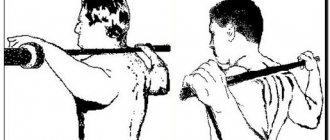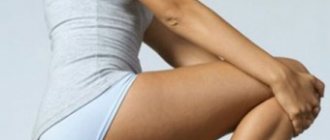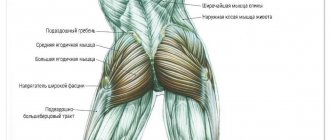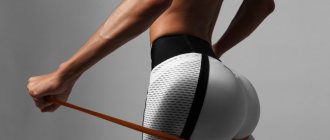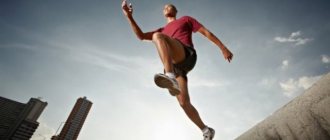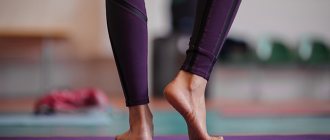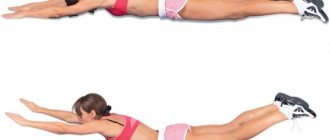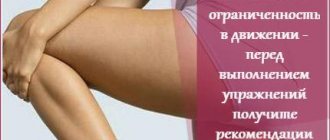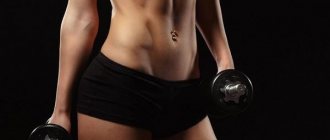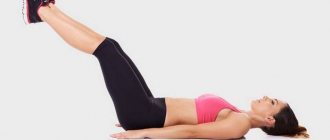Most women consider their legs to be the most problematic part of their body. Cellulite and excess fat deposits in this area are known to be difficult to correct. The only method that allows you to forget about this problem forever is a combination of regular exercise, a reasonable diet and massage. Exercises for the hamstrings can be part of a comprehensive leg workout or performed independently.
Exercises for the hamstrings will help make your legs strong and beautiful.
The whole point is that:
- it is this muscle group that is most often deprived of load due to sedentary work and low activity;
- trained muscles make legs stronger and more beautiful, making tasks such as running and climbing stairs easier;
- it helps eliminate cellulite and tighten the skin.
But in order to quickly see positive changes in the strength and appearance of your hips, experts recommend not limiting yourself to working on one muscle group. Combine the workout below with other exercises for your legs and hips. This approach is not only more efficient, but also saves time.
The best exercises for the hamstrings and buttocks
The back of the thigh is a problem area for most women.
It is susceptible to the formation of cellulite, which causes the skin there to become loose and lumpy. You can tighten it by strengthening your muscles. Men involved in sports also need to pay attention to the development of this muscle group. Otherwise, your legs will look disproportionate. In addition, weak muscles hinder progress in squats and other basic lower body exercises. WEIGHT LOSS STORIES OF STARS!
Irina Pegova shocked everyone with her weight loss recipe: “I lost 27 kg and continue to lose weight, I just brew it at night. » Read more >>
A large area on the back of the legs is occupied by the biceps femoris muscle. The semitendinosus and semimembranosus muscles are also located there.
This muscle group performs bending of the legs at the knees and their subsequent extension, as well as moving the pelvis back when tilting the body down. Accordingly, in order to pump up the muscles of the posterior thigh, it is necessary to perform exercises that imitate the listed movements. You can train your hamstrings both at home and in the gym.
Typically, men focus their leg training on developing the quadriceps. But it's not right. Strong hamstrings are essential to lifting weights in squats and some other lower body exercises. If this muscle group is lagging behind, you can forget about deep squats. In addition, strong muscles help avoid knee injuries and sprains.
In most exercises aimed at developing the muscles of the hamstrings, the buttocks are also included in the work, since they perform similar functions.
You can train your hamstrings at home. As equipment you will need to use dumbbells, a barbell or rubber expanders. If you can’t buy shells, you can take plastic bottles with water or sand.
To notice results, you need to exercise at home regularly. But you should not overuse training, otherwise the muscles will not be able to recover.
You should do no more than 2 classes per week. The following should be done no earlier than 24 hours after the muscle pain from the previous workout has passed.
The main basic exercise for the hamstrings is the Romanian deadlift. It allows you to stretch the back of your legs well and strengthen your buttocks.
But this exercise is dangerous if the technique is not followed. Therefore, beginners are recommended to perform it without additional weight until the movement is brought to automaticity.
The correct technique for performing the Romanian deadlift:
- pick up an apparatus (barbell or dumbbells);
- place your legs slightly narrower than your shoulders, feet parallel;
- from this position, begin to lean down with a straight back;
- The pelvis should be pulled back, the knees should be slightly bent;
- the weight should practically slide along the legs, otherwise the load will move from the hamstrings to the arms and back;
- lower the projectile to the middle of the shin;
- you should linger at this point, feeling the stretch in the back of your legs;
- then straighten up, pressing your heels into the floor and lifting the weight with the strength of your thigh biceps and buttocks.
You must not bend backwards at the top, otherwise you may get injured. Your back should remain perfectly straight throughout the entire movement.
Perform the exercise at a slow pace, feeling the work of the target muscles. Inhale when lowering, and exhale when lifting.
In addition to the classic version, you can do Romanian deadlifts on one leg. This exercise allows you to work out the muscles in more detail and, if necessary, correct their imbalance.
Romanian single leg deadlift
At home, you can perform such an effective exercise as lying down leg curls with a dumbbell. It is advisable to do it on a bench, and not on the floor, so that your legs hang in the air. Then the amplitude of movement will be most complete.
Exercise technique:
- lie on your stomach on a bench or similar horizontal object;
- the knees should extend slightly beyond its edge;
- You need to hold a dumbbell between your feet;
- firmly grasp the bench with your hands, pressing your body against it;
- as you exhale, bend your knees, lifting the dumbbell to a right angle;
- fixate at the top point, making a peak contraction;
- After this, straighten your legs, but do not fully straighten your knees so that the tension is maintained.
If you don’t have a bench or other suitable object at home, you can do leg curls while lying on the floor. In this case, it is best to use weights or a rubber fitness band rather than a dumbbell. She is pressed to the floor with one leg, and the other is bent at the knee.
Lying leg curl with rubber band
This exercise received such an unusual name because it resembles a bow when wishing good morning.
Several muscle groups are involved in the execution process: buttocks, extensors, muscles of the middle and lower back and the back of the thigh.
- place the barbell on your shoulders;
- lean forward, moving your pelvis back and slightly bending your knees;
- when the body becomes almost parallel to the floor, it is necessary to straighten up, straining the biceps of the thigh and buttocks;
- The back should be straight throughout the entire movement, the shoulders and chest should be turned.
You need to bend by moving the pelvis back, and not by simply bending at the lower back.
You should not use heavy weights in this exercise, as you may injure your back.
Squats are aimed at developing the muscles of the lower body. They involve many muscle groups, but usually the quadriceps receive the most work. To shift the emphasis and maximize the use of the hamstrings and buttocks, you must follow several rules:
- the movement should begin by moving the pelvis back, and not bending the legs at the knees;
- you need to squat deeply - to parallel with the floor or below;
- At the same time, the lower back should not peck, and the back should be rounded;
- the knees cannot be brought inward, they should point in the same directions as the socks;
- It is necessary to get up from a squat using the force of the buttocks.
If you squat correctly, the load will fall on the butt and hamstring muscles, which is especially important for girls. After practicing the technique, you can take weights - put a barbell on your shoulders, pick up dumbbells or bottles of water.
A glute bridge will help you work out your hamstrings and buttocks in isolation. This exercise is easy to perform both at home and in the gym.
- lie on your back with your knees bent;
- as you exhale, raise your pelvis, straining your buttocks so that your body forms a straight line;
- stop at the top and squeeze the muscles as much as possible;
- then return to the starting position, but do not lie on the floor so that the tension does not go away.
To increase the effectiveness of the exercise, it is necessary to use weights. To do this, you can take a pancake or a small barbell.
Glute bridge with a plate
To create a training program from the given exercises, you need to put them in the correct order. The table shows an approximate training plan for the hamstrings and buttocks.
| Exercises | Approaches | Repetitions |
| Squats | 3–4 | 10–12 |
| Romanian deadlift with dumbbells | 3–4 | 10–12 |
| "Good morning" | 3 | 15 |
| Lying leg curl with dumbbells | 3 | 12–15 |
| Gluteal bridge | 4 | 15–20 |
It is advisable to perform exercises 1-2 times a week. The rest of the time the muscles must recover. On rest days, it's a good idea to train other muscle groups or do cardio.
You can also work out in the gym. There are several more opportunities there, as special simulators are installed. In addition, the gym has more equipment and you can train in a frame that allows you to safely take a barbell for squats, Romanian deadlifts, etc.
In the gym you can perform all the exercises that are suitable for home exercises. Besides this, there are a few more additional ones.
Almost all gyms have a lying leg curl machine. To pump up your hamstrings with its help, you need to customize the design to suit you. This should be done in such a way that your knees hang slightly over the edge of the machine, and the roller is above your ankles.
After this setup, you can proceed directly to the exercise. Correct technique:
- lie down on the exercise machine bench, place your legs under the bolster;
- as you exhale, bend your knees, almost touching your buttocks;
- “squeeze” the biceps at the top and then straighten your legs;
- There is no need to completely straighten your knees so as not to damage them and maintain tension in the muscles.
Single leg squats
Squats themselves are very effective for the lower body. But it is squats on one leg that will really load and contribute to losing weight on the back surface. There are 2 types of this load, they differ in the location of the non-supporting leg. The difficulty of implementation is high, in addition to coordination, such a training of the hamstrings will perfectly work the necessary area and help burn cellulite on the legs.
Option one - standard
- Starting position – straight back, supporting leg slightly bent at the knee, the other, bent, pressed against the body;
- While inhaling, we squat as deeply as possible;
- After exhaling, we return to the original position.
Option two - pistol
- Starting position - the body is stretched out like a string, one straight leg is extended forward until it is parallel to the floor;
- Inhaling, a squat is performed;
- As you exhale, return to the upward position.
Watch the video for more details:
If it is difficult to perform actions on the floor, place your supporting leg on a support - a chair, stool or bench.
The exercise must be performed until the characteristic tension in the muscles occurs. For starters, 15-20 times in several approaches is enough. The time between sets is 30-45 seconds. If the load is easy, try picking up dumbbells.
And a little about secrets.
The story of one of our readers Alina R.:
I was especially depressed about my weight. I gained a lot, after pregnancy I weighed as much as 3 sumo wrestlers together, namely 92 kg with a height of 165. I thought the belly would go away after giving birth, but no, on the contrary, I began to gain weight. How to cope with hormonal changes and obesity? But nothing disfigures or makes a person look younger than his figure. At the age of 20, I first learned that plump girls are called “WOMAN” and that “they don’t make clothes that size.” Then at the age of 29, divorce from my husband and depression.
But what can you do to lose weight? Laser liposuction surgery? I found out - no less than 5 thousand dollars. Hardware procedures - LPG massage, cavitation, RF lifting, myostimulation? A little more affordable - the course costs from 80 thousand rubles with a nutritionist consultant. You can, of course, try to run on a treadmill until you go crazy.
And when will you find time for all this? And it's still very expensive. Especially now. Therefore, I chose a different method for myself.
Anatomy of the hamstring muscles
This muscle group consists of three muscles:
- Semitendinosus muscle of the thigh. A thin, long muscle located closer to the inner edge of the back of the thigh. Functions: hip extension, participation in flexion and rotation of the lower leg;
- Semimembranosus femoris muscle. A narrow, long muscle located on the inner edge of the back of the thigh. Functions: extends the thigh, flexes the lower leg, turns the lower leg inward when the leg is bent;
- Biceps femoris. Consists of two heads: long and short. Occupies most of the back of the thigh. Functions of the biceps femoris muscle: participates in leg extension, bends and rotates the tibia outward.
Hamstring muscles
Features of the training
In this case, the well-known principle - “we train lagging muscles at the end of the lesson” - does not work. After several approaches of squats and leg presses, there will be practically no energy left to pump up the hamstrings. Therefore, we propose the following rules for training the hamstring muscles:
- First priority. Place loads on the hamstrings at the beginning of the session. Don't worry, the muscle fibers of the thighs are very durable, so you can perform the following exercises in full.
- Quantity. It is believed that to grow small muscles you need to do 12 to 15 repetitions per set. With the hamstrings the opposite is true. Despite their small size, it is best to work them with serious weight and 6-8 repetitions.
- A complex approach. Do hamstring exercises in the same session as other leg exercises. The fact is that the quality of training increases if you pump antagonist muscles together (quadriceps are antagonists to biceps).
- Different types of loads. To pump up your hamstrings, combine isolation and heavy basic exercises in one training session. This principle of training allows you to use muscle fibers as deeply as possible and accelerate their hypertrophy.
Exercises for the inner thigh
The exercise can be performed with a crossover exercise machine or an expander rubber band. Stand with your right side to the crossover, hook the loop around the ankle of your right foot. Step back a little, pulling on the expander or crossover cable, and raise your working leg - this is the starting position.
Overcoming the resistance of the expander, place your working leg against the supporting leg, and then take it back.
Lie on your right side and lift your body, resting on your forearm. Bend your left knee and place your foot on the floor. Raise your right leg straight off the floor, hold for two to three seconds and lower.
Take a dumbbell or kettlebell in your hands, spread your legs wider, spread your toes to the sides. Squat down until your thighs are parallel to the floor or lower. Straighten up and repeat.
The exercise can be performed using steps or other elevations to deepen the squat.
Sumo squats with weights on steps
Top 5 exercises for hamstrings
It is more effective to work the biceps femoris muscles with heavy weights. Therefore, we offer exercises that are available to gym visitors, as well as to those who have minimal equipment (dumbbells or barbells) for training at home.
Power Lunges
If you want to tone your hamstrings, weighted lunges should be your go-to exercise. In this case, it is better to use a barbell rather than dumbbells as a weight. With a barbell, you will have to constantly monitor your balance, which will place additional stress on the target muscles.
- Place the barbell on your upper back (trapezius and rear deltoids).
- Stand up straight, straighten your spine.
- Taking a deep breath, step wide forward with one leg and lower your pelvis at the same time.
- Taking the lunge position, hold for 1-2 seconds.
- Then exhale and slowly return to the upright position.
- Repeat the movement starting with the other leg.
- Take your time, as there is a high risk of losing your balance and falling.
- When moving, try not to lean your body too far forward.
- Otherwise, a dangerous load will be placed on the knee joint.
Deadlift
The exercise perfectly works the muscles of the back of the thigh, and also strengthens the ligaments and tendons of the legs. Deadlifts can be done both with a barbell and in a Smith machine (an option for beginners). We'll look at free weight techniques.
- Prepare the barbell and place it on the supports of the power rack at knee level.
- Come up, take a straight closed grip and remove the projectile from the supports.
- Step away from the power rack, straighten up, and slightly move your shoulder joints back.
- Place your feet close to each other (approximately at a distance of 15-20 cm).
- With a deep breath, bend over and lower the barbell to your knees or slightly lower.
- Exhaling, slowly rise to the starting position, straightening your shoulders at the top point.
- When lowering the projectile, bend your knees slightly.
- Keep your spine straight throughout the entire range of motion.
Good Morning Tilts
The exercise perfectly stretches the entire back of the thighs, strengthening the muscles and tendons.
- Place the barbell on the power rack at the level of the pectoral muscles.
- Dive under the bar and press your upper trapezoid against it.
- Remove the barbell and step away from the power rack.
- Place your feet shoulder-width apart.
- With a deep breath, lean forward and move your pelvis back slightly.
- The depth of the tilt is up to the parallel of the body with the floor.
- Exhaling, slowly return to the starting position.
Deadlift
One of the most effective basic loads for the hamstring muscles. The front of the legs and the torso of the back are also involved. Also remember that this row is one of the best movements for lifting the buttocks.
Implementation complexity is medium. Concentration and endurance are required. It is better to use dumbbells or a barbell of a comfortable weight from the equipment.
- Starting position – feet shoulder-width apart, knees slightly bent, back straight, arched in the lower back, weights in the hands in the groin area;
- Inhaling, bend at the back, hands with weights slide along the body to the middle of the shin;
- Without stopping at the bottom point, we exhale and return to the starting position.
Watch the video for more details:
You should try to push off from the bottom point with the biceps and the muscles leading to it. If you don’t feel the area being trained, all your efforts are in vain.
Deadlifts should be performed in 3-4 sets of 6-10 times.
Carefully! The dumbbells or barbell must move strictly along the body. The farther the bar is from the body, the greater the negative load on the spine and the chance of injury.
Recommendations for training hamstrings
When doing a hamstring workout, follow these tips:
- Before exercising, warm up the muscles and joints of your lower body well.
- If your palm grip is weak, use wrist straps to hold the barbell in a deadlift.
- Work with large weights very carefully, do not allow pain in the muscles and joints of the legs.
- During the pause between sets, massage the muscles of the legs at the back to avoid “clogging” with blood.
- Avoid doing aerobic or jumping exercises after strength training your legs.
- At the end of the session, very carefully perform a simple stretch of the lower limbs.
Example training plan
As we have already said, it is better to train the biceps muscles on the same day as the other leg muscles. We offer an example of a comprehensive program for the lower body, but with an emphasis on the hamstrings.
- Warm-up (treadmill, bending, rotating the legs in the joints);
- Power lunges with a barbell (4/6-8);
- Squats (3-4/10-12);
- Deadlift (3-4/6-8);
- Leg press in the simulator (3-4/10-12);
- Russian Curl (3-4/10-12);
- Ab crunches (3/15-20).
At the end of the session, do a simple stretch on your legs. This will help relax the muscles of the lower body and reduce post-workout pain.
Complex in the gym
How can you strengthen the muscles of your buttocks and back of your thighs if you go to the gym? A universal complex that shows excellent results comes down to the following exercises:
- Treadmill. You need to run for about 20 minutes at a speed of 10 km/h. This will start the process of burning fat, speed up metabolism and warm up the muscles.
- Hyperextension. You need to adjust the equipment to your height. Secure your feet with the lower bolster. The hips lie on special pillows, hands behind the head, the whole body is tense and represents a straight line. Inhale and bend down, fix the point for 1-2 seconds, then return to the starting position and repeat the movement.
- Leg bending in the simulator. Lie down on a bench and position the bolster so that it rests on your ankles. Inhale and bend your legs so that the roller touches your buttocks. Smoothly we return back.
- Leg press in the simulator. We lie down on a bench, raise our legs and place them on the upper edge of the platform, slightly wider than shoulder level. You need to push the platform with your feet, focusing on your heel. It is important to keep the distance between your legs at the same level.
If you are a regular visitor to a sports club and your level of training allows, you can complicate the exercises by performing the movements more times, increasing the weight, or training each leg in turn.
Effective exercises for the hamstrings
Often, athletes work hard to pump up their quadriceps, but don't pay enough attention to training their hamstrings. But they perform important functions in bending the legs at the knee joint and stabilizing it. In addition, unevenly pumped legs look disproportionate. A set of highly targeted exercises will help you effectively pump up your hamstrings in the gym and achieve impressive results.
The biceps femoris includes several flexor muscles located on the back of the thigh. Their main function is to bend the legs at the knee joint.
Ways to pump up the hamstrings
Prolonged sitting, prolonged bed rest, and muscle overload can have a negative effect on the hamstring muscles. Therefore, people leading a sedentary lifestyle need to know how to pump up the hamstring muscles and exercise regularly in the gym or at home.
Important: Most athletes often strive to pump their quadriceps legs more thoroughly. In this case, a certain load is placed on the biceps, but this is not enough for the uniform development of the muscular system of the legs. The workout should include isolated exercises for the hamstrings.
Anatomical features of the femoral biceps
To figure out how to pump up your thigh muscles, you need to study the structure of this muscle group, as well as the functions they perform.
Anatomy of the muscles of the legs and buttocks
The posterior muscles of the femoral leg include:
- biceps;
- semimembranous;
- semitendinosus.
The biceps muscle consists of two bundles that run along the thigh and are attached to the head of the fibula. The semitendinosus muscle runs along the inside of the thigh. The semimembranosus is attached to the ischial tuberosity from above and reaches the tibia.
The main functions of the biceps femoris are:
- bending the leg at the knee joint;
- stabilize the knee;
- in combination with the gluteus maximus muscle, it participates in the extension of the torso;
- shin rotation.
We previously wrote about a lying knee bending machine and recommended bookmarking this article.
Usually in fitness and bodybuilding they use a set of traditional basic and isolated exercises that involve all the muscles of the back of the thighs.
Pumping up your legs at home is not that difficult. All you need is the desire to achieve your goals at all costs and firm confidence in your abilities. Before you start training, you should consult with a trainer who, in accordance with your physical fitness, will select a set of exercises and determine the training regimen.
Readers found these materials useful:
Stepping onto the platform
Tension of the leg muscles when lifting onto the platform allows you to clearly isolate the hamstring muscles. In addition, it helps solve the problem of how to pump up the lateral thigh muscle without fear of injuring your back. The exercise is more gentle on the spinal column than bench presses and deep squats, so it is recommended for people with problems in the lumbar region.
Performing steps onto an elevated platform
To increase the load, use dumbbells. When performing, they are held in each hand along the body. Starting with your right foot, step onto the raised platform. Leaning on it with the entire surface of the foot, place the left foot next to the right. To return to the starting position, the left leg is lowered first.
Instead of dumbbells for men, you can use a barbell, holding it on your shoulders. Don't take on a lot of weight right away. When performing steps onto the platform, it is difficult for a beginner to maintain balance even without weights. The average number of repetitions is 8-12 times.
This material will be perfectly complemented by the following publications:
Leg raises while lying on your stomach
An excellent static load for girls and women, acting mainly on the biceps femoris muscle. The difficulty is not high, the main thing is to concentrate on the area being worked and feel the muscle tension in it. This movement is also called “Lying Hyperextension.”
- Starting position - Lay a mat, lie on your stomach, arms and legs straight and extended down;
- As you inhale, we lift 2 straight legs up 15-20 centimeters from the floor level, hold for 2-3 seconds;
- Exhaling, we come to the starting position.
More details in the video:
You can perform actions on both legs at once, or separately on each. To begin with, 15-20 repetitions in 3-4 approaches will be enough.
You can perform the exercise without weights, or use weights on your calves or ankles.
Leg Curls
The exercise is one of the most effective, aimed at the hamstrings while lying down. By doing it correctly, you can improve the relief and shape of the thigh. Visually lengthens it due to the thickening of all muscle bundles.
Lying leg curls
First of all, you should adjust the exercise machine to your height. The exercise is performed lying on a bench with your back up. With the legs fully extended, the back surface of the shin rests against a movable roller with a certain weight. The torso should be straight. During exhalation, bend your legs, raising the roller as much as possible. After a few seconds, exhaling, lower your legs to the starting position. On average, do 10 - 12 repetitions.
Important: To prevent back and hamstring injuries, do not use too much weight at once. Your body should always be in a stable position.
Standing leg curls are aimed at working all muscle groups in the back of the thigh. For girls, this exercise is attractive because it trains and tightens the lower biceps. Due to this, the femoral part is visually lengthened, thereby improving the proportions of the legs.
Standing leg curls
Having adjusted the machine to your parameters, grab the handrails with your hands and slightly bend your lower back. Rest the front surface of your thigh against a special support, place the lower part of your shin under the roller.
While exhaling, bend your leg, raising the roller as high as possible, and stay in this position for several seconds. Then inhale and lower the leg to the starting position. It is enough to do 10-12 times on each leg in turn.
Seated leg curls help solve such a difficult task as pumping up the inner thigh muscles. The exercise trains the semitendinosus and semimembranosus muscles well, aligning them with the more developed biceps.
Seated leg curl technique
Jumping Lunges
The combination of aerobic and strength training will have a wonderful effect on tightening your figure. The complexity of the execution due to jumping is quite high .
In addition to the main muscle group being worked, lunges will help tighten the buttocks and calf muscles.
- Starting position – Legs together, back straight, arms at your sides, gaze directed forward;
- As you inhale, lunge forward with your right leg, exhale while hovering;
- On the next inhalation, we jump and land in a lunge on the other leg.
Learn more from the video:
You can do this exercise with or without weights. For beginners, you should start with 10-12 repetitions on each leg in 2-3 sets.
For the necessary coordination of movements, help yourself when jumping with characteristic swings of your arms.
How to pump up your legs: 5 training schemes.
What is the true sign of a powerful, athletic physique? Is it a big, pointed bicep? Are these carved abdominal muscles? Is it shoulders like bowling balls or a wide, thick back? None of them are correct. The real answer is SYMMETRY. A "Symmetrical Physique" is one in which all parts of the body flow smoothly into each other. No part of the body or side of the body is larger in percentage terms than another.
If this is an article about building legs, why talk about symmetry? I bring up the topic of symmetry because too many beginners and more advanced athletes alike, don't really care about training their leg muscles and skip these workouts (or just do half the task) and thereby create a terrible imbalance between the sizes of the upper and lower parts of the body. .
This completely abolishes the concept of symmetrical development of the body. There is nothing funnier than seeing a guy at the gym with well-developed upper body muscles and legs like toothpicks)))
Today you will be presented with 5 ways, 5 training schemes to make your legs strong, powerful and muscular. How to pump up your legs: 5 training schemes. Everything will be clearly stated in this article. I’ll say right away that not everyone will be able to complete these workouts - this is not an easy task, you can believe me. But if you master it, the result will be obvious!
I will talk about the anatomy of the legs, their functions, locations in the body, and some exercises for each muscle area.
Quadriceps.
Rectus femoris muscle.
- Function: Hip flexion (pulling the thigh towards the abdomen). Shin extension (leg extension at the knee)
- Location: The long fusiform muscle is located on the front of the thigh above all the other quadriceps muscles. With its upper end, the muscle is attached to the pelvic bone (lower anterior iliac spine above the acetabulum), and with its lower end it participates in the formation of the knee ligament.
- Exercises: Squats with a barbell.
Vastus lateralis muscle.
- Function: Extends the lower leg (extends the leg at the knee)
- Location: Located on the lateral surface of the thigh and extends onto the front of the thigh in the knee area. The upper end is attached to the femur in the area of the hip joint. Bottom - to the patella and tibia (tibia).
- Exercises: Hack squats.
Vastus medialis muscle.
- Function: Extends the lower leg (extension of the leg at the knee)
- Location: A thick, flat muscle located on the inside of the thigh, extending onto the front of the thigh near the knee. This muscle forms a rounded ridge on the inside of the knee, especially noticeable when you are sitting. With its upper end, the muscle is attached along the entire length (from the inside) of the femur, and with its lower end it forms the suspensory ligament of the patella.
- Exercises: Leg extensions, lunges.
Vastus intermedius muscle.
- Function: Extends the lower leg (extends the leg at the knee)
- Location: This is a flat lamellar muscle, located between the vastus lateralis and vastus medialis muscles. Hidden under their edges and covered on top by the rectus femoris muscle. The upper end of the muscle is attached to the femur in the area of the hip joint, and the lower end participates in the formation of the patellar ligament.
- Exercises: Jumping, squats, lunges.
Muscles of the back of the thigh.
Semitendinosus muscle.
- Function: Extension of the hip (pulling it back or straightening the body from a tilted position). Shin flexion (bending the leg at the knee).
- Location: A long, flat, tapering muscle lying medial (closer to the middle of the body) in relation to the biceps femoris muscle. The upper part of the muscle is attached to the ischial tuberosity of the pelvic bone. The lower one is to the tibia (lower leg).
- Exercises: Body extension, lunges, leg curls.
Semimembranosus muscle.
- Function: Extension of the hip (pulling it back or straightening the body from a tilted position). Shin flexion (leg bending at the knee)
- Location: Long flat muscle, located in the posterior inner part of the thigh. The upper end is attached to the ischial tuberosity of the pelvic bone. The lower end - to various parts of the tibia and fascia of the lower leg muscles.
- Exercise: Leg Curl.
Biceps femoris muscle.
- Function: Flexion of the shin (bending the leg at the knee). Hip extension (moving the hip back or straightening the torso from a tilted position). Maintaining body balance.
- Location: Long, spindle-shaped muscle that runs along the entire back of the thigh. It consists, as the name suggests, of two heads: long and short. The long head is attached at the upper end to the ischial tuberosity of the pelvic bone, and at the lower end to the tibia (tibia). The short upper part is attached to the back surface of the femur, and the lower part is attached to the tibia.
- Exercises: Leg bending, sitting, lying down, body extension.
Calf muscles.
Calf muscle.
- Function: Movement of the foot in the sagittal plane and stabilization of the body during movement (walking and running).
- Location: Biceps muscle on the back of the human leg. Located above the soleus muscle, together with which it is attached to the heel through the thick Achilles tendon.
- Exercises: Standing calf raises.
Soleus muscle.
- Function: Participates in flexion of the foot at the ankle joint.
- Location: The soleus muscle is attached superiorly to the head and upper third of the body of the fibula along its posterior surface, as well as to the line of the soleus muscle of the tibia; From below, the muscle is attached to the heel tubercle by the Achilles tendon.
- Exercises: Seated calf raises.
Rep range.
As you can see from the anatomical information, the legs make up the largest muscle mass in the human body. A person uses their legs every day for the main activities of their lives (walking, standing still, climbing stairs, or simply getting out of a chair). What does this mean for you as someone who trains?
If you want to add size to your legs, increase their muscle mass, then training limited to half measures will not give you anything; Don’t forget, your legs are accustomed to daily, everyday stress. Therefore, only dedication to intense hard work in the gym will shake up the dense, thick muscle fibers of the legs, and their only choice will be to become bigger and stronger.
Your task is to make your legs grow! The work is not easy, because the muscles of this group take a lot of strength and energy when you give them the necessary load. Muscle burning, post-workout pain, heavy training are the only way to develop leg muscles.
The legs are made up of many muscles, so you will need to use good training volume, multiple angles, and a variety of exercises to stimulate all the muscles. The range will depend on the types of exercise. I like to use the lower rep range (4-6) on most heavy, compound, compound exercises to build a strong foundation of leg muscles.
For isolation exercises, it's good to use a moderate (8-12) to high rep range (15-20). This helps to achieve an excellent muscle pump and stimulate their growth (productive pump) and reflex changes in muscle tissue and fascia.
All exercises must be performed with perfect form because poor form with any weight lifting movement or the habit of doing everything wrong will follow you and lead to lack of progress or worse, serious injury!
